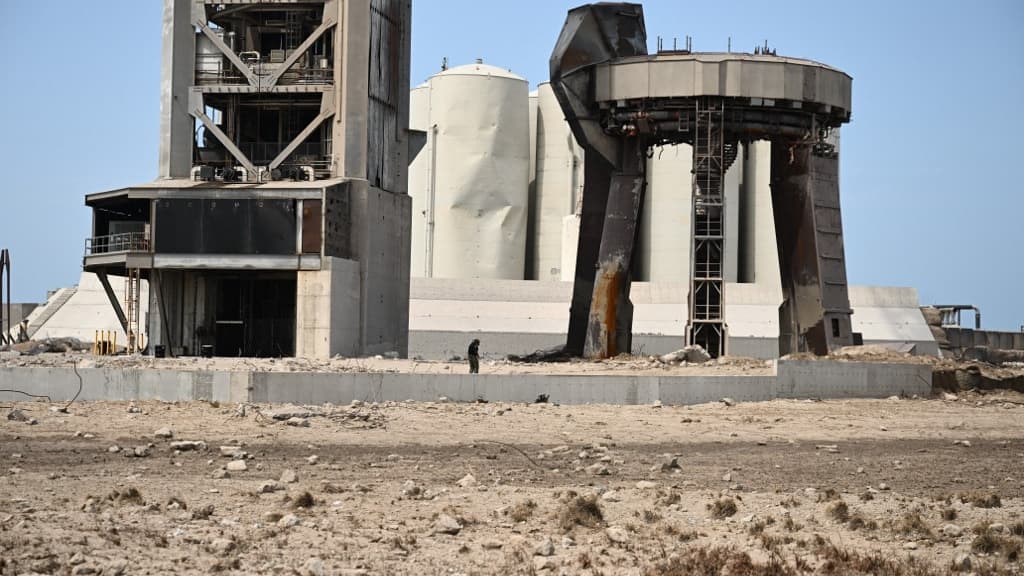
The SpaceX launch pad in Texas shook with the force of the spacecraft’s launch
Elon Musk admitted that the company “mistakenly” thought it would stand the test. Before it can fly again, in addition to boosting its launch pad, SpaceX will have to determine the cause of the problems it encountered during the flight.
Bits of concrete tossed, bent, and craters dug into the ground… The force of the first take-off of SpaceX’s new rocket, Starship, the world’s largest and most powerful, severely damaged the launch pad in Texas.
The damage caused will likely take several months to repair. And so they could delay the next test flights, and thus quickly develop that rocket that NASA is counting on to send its astronauts to the moon.
“break concrete”
Before Thursday’s test flight, SpaceX chief Elon Musk’s only wish was “not to destroy the launch pad.” His fear: that the missile would explode even before it could tear itself off the ground—which it finally did after four minutes of flight over the sea.
But the company appears to have underestimated the damage a simple take-off of this 120-meter-tall mastodon could cause.
“The engines, when they ignited, may have broken down the concrete, not just corroded it,” Elon Musk wrote on Twitter on Saturday.
Several months of repair
The giant launch tower withstood the shock. The massive base on which the vehicle rests (the launch table) is also still there, even if it has been damaged. But under it, a deep hole was dug, judging by the photos that specialists posted on social networks.
Everywhere a scene of desolation reigns. SpaceX video during liftoff shows debris falling into the nearby sea. Local newspapers reported that a cloud of dust had reached a small town several kilometers away.
“The radius of debris and disturbance was probably greater than anyone expected,” said Olivier de Weck, a professor in MIT’s Department of Aeronautics and Astronautics.
“The main damage to the launch pad is below, where flames (from the engines) attack the ground,” explained Olivier de Wyck, many of whose former students work for SpaceX. “The hole that has been created needs to be filled in and repaired, and that will certainly take several months.”
Protection is not “just in time”
The Starship launcher does not appear to be equipped with two attachments normally used for heavy launchers. First, the “flood”: huge amounts of water are poured in at the exact moment the engines ignite, in order to dampen the sound waves, and reduce the vibrations.
Then, a “jet deflector” (or stacks): a system of tunnels that allow redirection of off-gases, shielding both the concrete and the rocket. But they are very expensive to build, especially since they have to be adapted to the size of the rocket – disproportionate in the case of the Starship.
After the test, Elon Musk explained that the company began building a “water-cooled steel plate” to be placed under the base of the rocket, and ultimately was not “ready in time.”
He admitted that the company “mistakenly” thought the launch pad would stand the test, adding that a new launch would likely be possible “in a month or two”.
“more success than failure”
Such a steel plate “would make sense, and I think it would work,” said Philip Metzger, a former NASA employee who worked on the physics of launch pads. He explained that sprinkling it with water would prevent the “plaque” from “dissolving”.
This wouldn’t solve the sound wave problem, but “you could build a rocket strong enough to withstand it,” estimates this University of Central Florida scientist. He noted that designing a launch pad is as complex as developing a missile.
NASA’s new massive rocket, the SLS, which lifted off for the first time in November from Florida, also caused damage, notably putting out launch tower elevators.
Before it can fly again, in addition to boosting its launch pad, SpaceX will have to determine the cause of the problems it encountered during the flight. Several engines failed, and the two rocket stages failed to separate as expected, forcing SpaceX to activate the self-destruct command.
Finally, it will be necessary to convince the air regulator, the FAA, to authorize the Starship to take off again, Olivier de Wieck has pointed out. The agency confirmed that Thursday’s test did not result in any injuries, and said it was supervising the investigation into the blast. She emphasized that a new test flight would be contingent on public safety.
Contrary to intuition, this first test remains “more a success than a failure,” according to Olivier de Wyck. “SpaceX has to develop these amazing capabilities, because they’re willing to take risks and break things — but they’re learning from it.”
The most important items

“Incurable web evangelist. Hipster-friendly gamer. Award-winning entrepreneur. Falls down a lot.”
